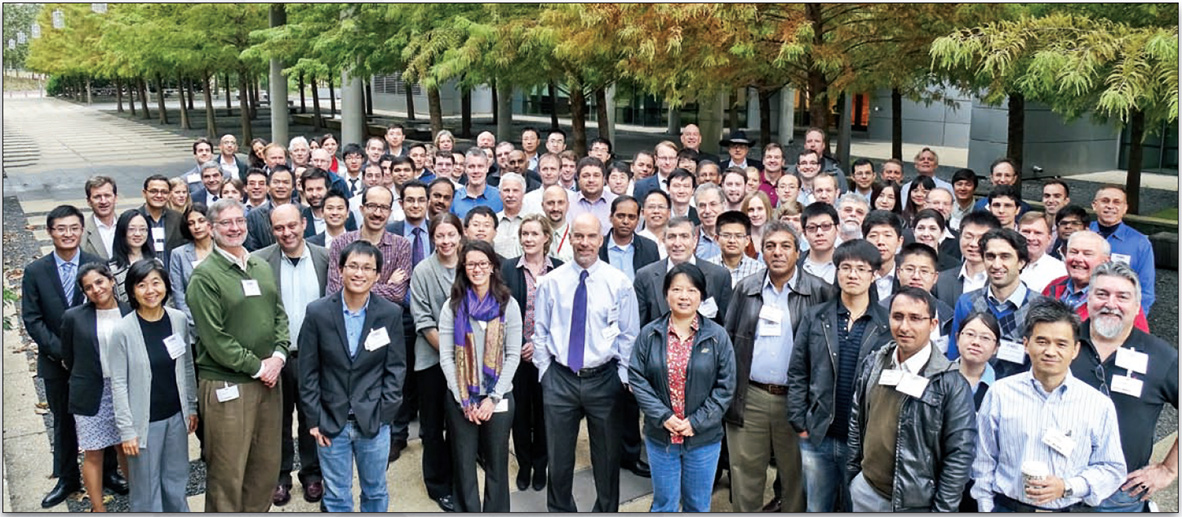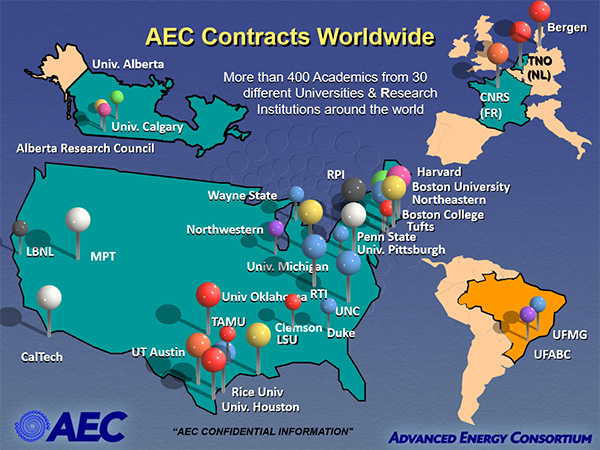The Advanced Energy Consortium

The Advanced Energy Consortium (AEC) is an internationally recognized research consortium founded by and based at the university of Texas, Austin’s Bureau of Economic Geology in 2008. The consortium is dedicated to achieving a transformational understanding of subsurface through the deployment of the world’s most advanced micro/nano sensors and materials technologies. Our consortium is dedicated to the following:
- Mission: Develop disruptive nanotechnology to optimize energy production
- Vision: To enable transformational improvement in subsurface sensing, energy recovery, and environmental protection
- Goal: Worldwide commercial adoption of breakthrough nanotechnology for sustainable energy production
- Approach: Enable rapid prototyping of applied nanotechnology concepts to a TRL of >3 through collaborative research among scientists, industry leaders, and governmental agencies.
The AEC’s technology “reach” now extends beyond the consortium’s original mission, which focused on oil and gas exploration. We are targeting CO2 sequestration and utilization, pipeline surveillance, environmental monitoring, cement integrity, geothermal, plug and abandonment, and more. The development of distributed, real-time, miniaturized subsurface sensors and materials, with the associated data analytics, promises to provide revolutionary monitoring tools to our member companies to address the “emission transition” in a more economical and environmentally safer manner, while remaining profitable.
Essential aspects of the success of our consortium include the following:
- Fostering innovation and international cooperation, including engagement of the industrial and academic communities. Our flexible research model has continued to function during the pandemic.
- Developing revolutionary sensors and advanced materials approaches that illuminate the reservoir for enhanced commercial extraction of resources.
- Leveraging our members’ financial investment and the collaborative intellectual impact with our academic partners to take advantage of governmental grants.
- Establishing the AEC as an international clearinghouse for data and ideas related to subsurface micro- and nanosensing technology.

Many projects have been commercialized by current and former members of the AEC. Many students and postdoctoral fellows whom the AEC funded are now actively pursuing energy research. AEC has begun discussion about a commercial valuation/evaluation exercise on its newest high TRL prototypes. We are excited about the opportunity to be at the leading edge of science and technology development for energy solutions, and we thank the members for their continued support of this mission.
We invite companies ready to transform the energy industry's future to talk with us about empowering energy for people and the environment using our advanced technology. Joining the AEC gives prospective members access to more than $55 million worth of completed research, including participation in commercial-scale field tests of our applications. This will position new members to capture the results of 14 years of research and development that will allow member companies to lead in technology commercialization. Now is an excellent time to join the AEC.
For membership and partnership information, please contact the AEC Principal:
Mohsen Ahmadian
512-471-2999
mohsen.ahmadian@beg.utexas.edu

Accomplishments:
Since inception, the AEC has had more than:
- >40 patents
- 275 publications
- 33 university and institution research partners
$50 million invested in research and development have created breakthrough technologies in:
Microfabricated Sensors
- High temp batteries and capacitors
- Micro-pressure sensor with less than 1psi resolution
- Up to 10k psi, 125C, and 1,200 measurements were taken
- 53% recovery of 9mm sensors from downhole
- Microsensor systems on a chip as small as 1mm long and 1mm wide
Contrast Agents
- Remote imaging of hydraulically fractured network boundaries with 5’ lateral precision has been achieved
- Flow anisotropy detection with magnetic nanoparticles has been demonstrated
- Coating for stabilizing nanoparticles in API brine and 95C for more than one month has been developed
Payload Delivery Systems
- Multiple time/temperature-triggered platform nano-payload technology has been developed
- Over 90% weight equivalent of 12M HCl has been encapsulated
- Nano scale inhibition and nano-asphaltene inhibitors for prolonged squeeze treatment